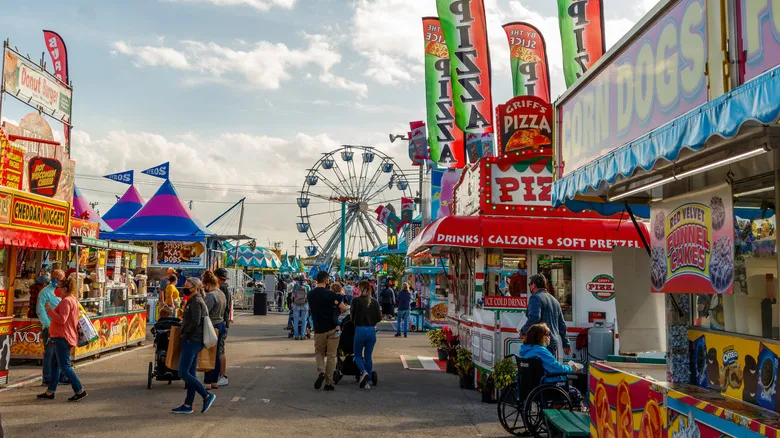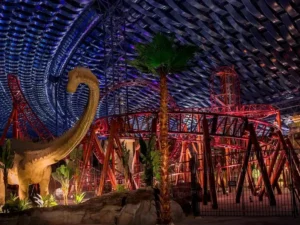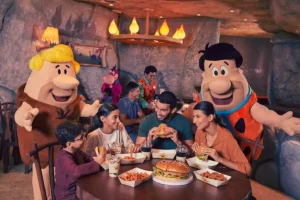
Blogs
Innovative F&B Strategies: Creating Memorable Dining Experiences in Theme Parks
Dining in theme parks is no longer about satisfying hunger—it’s about creating experiences that become a core memory of the visit. With evolving visitor expectations and technological advancements, innovative F&B strategies have transformed food services into a major attraction. Well-designed dining offerings don’t just enhance the guest experience; they also drive foot traffic, boost revenue, and solidify the park’s position as a complete entertainment destination.
In this blog, we’ll explore how theme parks are leveraging creativity and technology to deliver unforgettable culinary journeys.
The Role of F&B in Enhancing Visitor Experiences
F&B services in theme parks are more than just meals; they’re an integral part of the overall attraction. Here’s why F&B is critical:
- Boosting Engagement: Themed dining spaces can captivate visitors just as much as rides.
- Increasing Revenue: Food services, coupled with creative packaging and branding, are significant income streams.
- Driving Repeat Visits: Unique and immersive dining options encourage visitors to return for the complete experience.
- Supporting Local Tourism: Regional flavors and dishes give visitors a taste of local culture, enhancing their connection to the park.

Themed Dining Spaces: Culinary Storytelling
Theme parks are built on storytelling, and their dining spaces are no exception. Immersive themes create a seamless narrative that extends into the meals.
- Fantasy-Themed Cafés: Dining in a magical realm where desserts look like works of art.
- Adventure Zones: Rustic BBQ pits or outdoor food stations designed to complement adventure rides.
- Interactive Dining Experiences: Restaurants where food preparation becomes part of the show, such as live pizza tossing or flambé demonstrations.
- Cultural Integration: Incorporating regional themes, like a snow-themed café in winter parks or local delicacies in tropical zones.
Themed dining transforms mealtime into an attraction, ensuring it’s not just functional but also memorable.
Technology-Driven Dining: Efficiency and Innovation
Modern technology is revolutionizing dining services in theme parks. With high visitor volumes, seamless and efficient operations are crucial.
- Self-Serving Kiosks: Allow visitors to customize their meals and avoid long lines.
- RFID Cards and Wristbands: Enable cashless transactions for quicker purchases at food counters.
- Mobile Pre-Ordering: Apps let visitors order food in advance, reducing wait times during peak hours.
- Automated Kitchens: Robots ensure consistency and efficiency in food preparation.
By integrating these technologies, parks not only streamline operations but also enhance visitor satisfaction.

Seasonal and Regional Menus
Offering seasonal and regionally inspired menus is a smart way to cater to diverse audiences while staying relevant.
- Seasonal Specials: Winter parks may feature hot chocolate, while tropical parks focus on cooling beverages and fresh fruit platters.
- Regional Dishes: Highlighting local cuisine provides a cultural connection for visitors and supports local producers.
- Climate-Specific Dining Spaces: Warm, cozy cafes in snowy environments or open-air dining in tropical areas create comfort and enhance the experience.
These curated menus add variety and ensure the F&B offerings remain fresh and appealing.
Immersive Dining: Turning Meals into Entertainment
For theme parks, dining doesn’t just need to be satisfying—it needs to be an experience. Immersive and entertaining dining setups are becoming a major draw for visitors.
- Themed Restaurants: Spaces with decor, music, and menus tailored to a specific theme, like a pirate ship or a futuristic space station.
- Dining with Shows: Live cooking performances or dinner theaters where visitors enjoy meals alongside entertainment.
- Virtual Reality (VR) Dining: Guests eat while immersed in a VR adventure that complements their meal, such as a medieval banquet or a futuristic feast.
- Interactive Seating: Motion chairs or dining tables that enhance the experience through small movements or integrated sound effects.
These immersive elements turn dining into a memorable event that visitors talk about long after their trip.
Group-Friendly Dining Spaces
Theme parks attract families, friends, and corporate groups. F&B strategies must cater to these diverse audiences with inclusive and flexible offerings.
- Multi-Cuisine Buffets: Options for every taste and dietary requirement, perfect for large groups.
- Dedicated Kids’ Menus: Meals that are both healthy and exciting for younger visitors, such as colorful dishes or bite-sized portions.
- Family-Friendly Seating: Large communal tables or private dining spaces to accommodate groups of all sizes.
- Corporate-Friendly Options: Premium dining packages for business outings or corporate events.
These strategies ensure all guests, regardless of group size, feel welcome and valued.
Sustainable Dining Practices
Sustainability is no longer optional—it’s a must. Eco-friendly practices in theme park dining not only appeal to conscious visitors but also reduce operational costs.
- Reusable Utensils: Phasing out single-use plastics in favor of reusable or biodegradable options.
- Locally Sourced Ingredients: Fresh produce from nearby suppliers ensures quality while supporting local economies.
- Food Waste Management: Composting and recycling initiatives integrated into the park’s dining operations.
- Energy-Efficient Kitchens: Using equipment designed to minimize energy consumption.
Sustainability aligns parks with modern consumer values and enhances their reputation.
Merging F&B with Merchandise and Attractions
Innovative parks blend their F&B offerings with other aspects of the guest experience, like merchandise and attractions.
- Exclusive F&B Merchandise: Branded cups, plates, and napkins that visitors can take home.
- Ticket Bundles: Packages combining meals, rides, and souvenirs for a complete experience.
- Photo Opportunities: Themed dining spaces designed for Instagram-worthy shots encourage social media sharing.
- Interactive Redemption Systems: Rewarding visitors with meal discounts or free treats through redemption tickets or loyalty programs.
This cross-promotion between F&B and attractions ensures guests spend more time—and money—in the park.

Why F&B Strategies Are Critical for Success
Well-planned F&B strategies do more than feed visitors; they create a seamless and engaging experience that elevates the park as a whole. From drawing in foot traffic to enhancing the park’s identity, innovative dining solutions are vital.
At Peach Prime Consultancy, we specialize in creating immersive, functional, and profitable F&B strategies for theme parks. Whether it’s designing themed food courts, integrating self-serving kiosks, or planning a snow café in a winter park, our expertise ensures your dining spaces leave a lasting impression.
At Peach Prime Consultancy, we specialize in creating innovative F&B experiences for theme parks, blending creativity with functionality. We specialize in budget planning and cost estimation to ensure your project stays within financial expectations. By providing a detailed breakdown of the total project cost. We design themed dining concepts that align with the park’s narrative while optimizing foot traffic and operations. With advanced technologies like self-serving kiosks, RFID systems, and cashless payments, we streamline dining services. We also emphasize sustainability and local cultural elements for authentic experiences. Our strategies help parks maximize revenue and guest satisfaction in cities such as London, Paris, Berlin, Rome, Madrid, Moscow, Istanbul, Athens, Amsterdam, Vienna, Prague, Budapest, Lisbon, Brussels, Warsaw, Stockholm, Zurich, Copenhagen, Oslo, Helsinki, Bucharest, Belgrade, Zagreb, Ljubljana, Tallinn, Reykjavik, Skopje, Tirana, Sarajevo, Sofia, Chisinau, Podgorica, Vilnius, Riga, Kiev, Monaco, Andorra la Vella, Luxembourg City, Cardiff, Porto, Geneva, Antwerp, Milan, Lyon, Barcelona, and Marseille.










